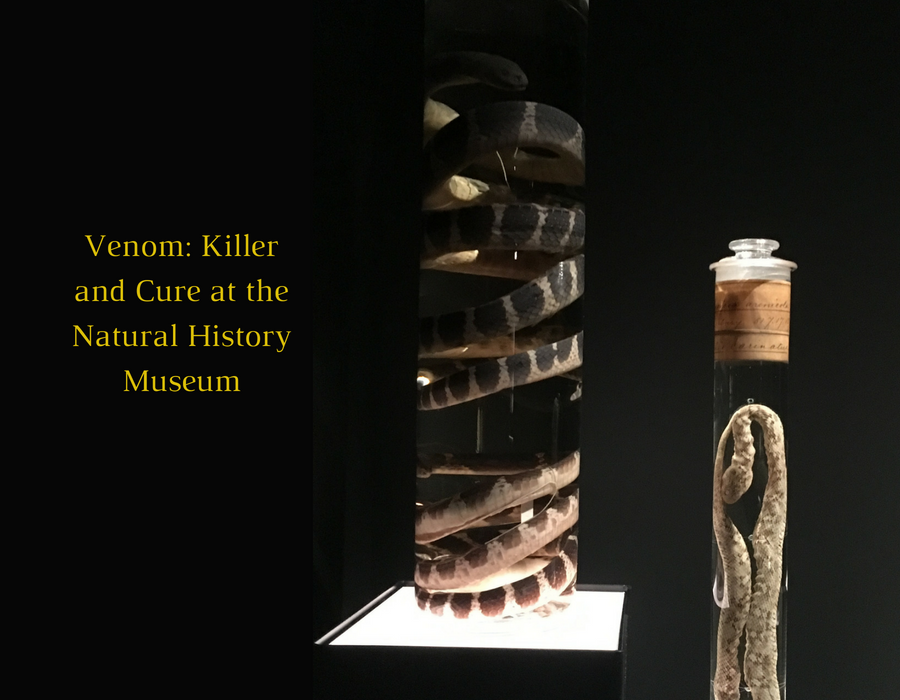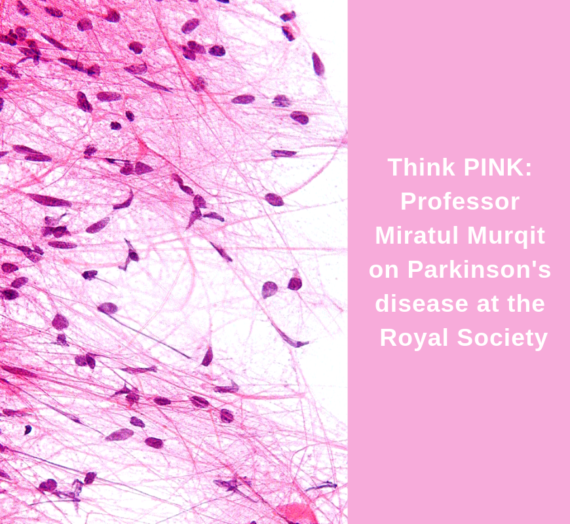Roisin Conneely
In part 1 of our review of the Natural History Museum’s “Venom” exhibition, we explored the diversity of venomous species on Earth, as well the range of uses venom has, from hunting, defence, mating and more. In this article, we’ll take a look at some historical attitudes to venom and ancient treatments, as well as modern medicine and some more unorthodox uses of venom that may never have crossed your mind!
Just how dangerous is venom?

Scientists gauge the lethality of venom using the LD50 measures – or median lethal dose – which shows the amount of venom required to kill half the number of animals in a test population. The lower the value, the more lethal it is. Not all species have been measured, but so far, one of the deadliest animals known is the coastal taipan snake (Oxyuranus scutellatus) of Australia, its venom can paralyse prey and disrupt blood clotting, leading to death just 30 minutes after the bite in severe cases.
The Schmidt pain scale
The Schmidt pain scale was created by Justin O Schmidt, and measures pain inflicted by stings of insects such as ants and bees. Using himself as a test subject, he has allowed himself to be stung by more than 80 insect species.

 Pain level one includes stings from species such as the red fire ant (Solenopsis invicta), which is described as “sharp, sudden, mildly alarming”. Included in level 2 are the glorious velvet ant (Dasymitilla gloriousa), and the western honey bee (Apis mellifera) which Schmidt claims is “burning, corrosive, but you can handle it”. Moving up to level 4, the highest pain rating, we find the warrior wasp (Synoeca septentrionalis), bullet ant (Paraponera clavata) and the tarantula hawk wasp (Pepsis sp). According to the Schmidt scale, the bullet ant’s bite is comparable to “walking over flaming charcoal with a three-inch nail embedded in your heel), whilst the tarantula hawk wasp is “blinding, fierce, shockingly electric.”
Pain level one includes stings from species such as the red fire ant (Solenopsis invicta), which is described as “sharp, sudden, mildly alarming”. Included in level 2 are the glorious velvet ant (Dasymitilla gloriousa), and the western honey bee (Apis mellifera) which Schmidt claims is “burning, corrosive, but you can handle it”. Moving up to level 4, the highest pain rating, we find the warrior wasp (Synoeca septentrionalis), bullet ant (Paraponera clavata) and the tarantula hawk wasp (Pepsis sp). According to the Schmidt scale, the bullet ant’s bite is comparable to “walking over flaming charcoal with a three-inch nail embedded in your heel), whilst the tarantula hawk wasp is “blinding, fierce, shockingly electric.”
Ancient cures

Brooklyn papyrus: one of several medical papyri originating from ancient Egypt, the Brooklyn papyrus dates to approximately 600 BC, and contains one of the oldest accounts of snakebite symptoms and potential treatments. The display depicts extracts from the papyrus, including descriptions of surgical interventions, as well as herbal and magical treatments.

Cippi are ancient Egyptian healing stones which have spells engraved into them, and were used to treat snake and scorpion bites. The stones in the exhibition depict the face of Bes, the god of domestic safety, and Horus-shed, the child-god. Ancient Egyptians would have poured water over these stones, and then collected the water and pour onto the envenomation wounds in order to heal them.
Surprisingly, the modern techniques we currently employ for venomous wounds may not be as helpful as we might expect. Tourniquets, which act to cut off blood flow in order to prevent the spread of venom, can actually worsen tissue damage. Suction devices can also be detrimental to wound healing and actually only remove a small percentage of venom. Stun guns are often mistakenly believed to break down venomous toxins, but can also worsen the destruction of tissue, and are banned in the UK.
Some less conventional methods are also employed by people all around the world, for example, Australian Indigenous people, heat and crush leaves of the goat’s foot plant (Ipomoea pes-caprae) and apply to wounds inflicted by stonefish, stingray and insect stings to stop pain and bleeding. In South Asia, venomous species are plentiful, hence people have developed healing methods over thousands of years, many of which are still employed today. A The Sanskrit manuscript from 1847 recommends the use of the Mimosa pudica plant for the healing of envenomed wounds, however there is still uncertainty about the scientific efficacy of this method.
Anti-venom
Anti-venom was developed in the 19th century, and was a huge milestone for medicine. The methods remain relatively unchanged to this day, with milking venom from snakes and then injecting it into horses still a major part of the technique.

 Snakebites cause over 100,000 deaths worldwide annually, which, given the fact that they are actually treatable, makes this statistic all the more tragic. The most at-risk individuals are those in poor areas who simply cannot afford anti-venom treatments. It seems that, lacking a profitable demographic, pharmaceutical companies have reduced their production of life saving anti-venom drugs. It’s now more important than ever that scientists work to produce more affordable and safer treatments that can be made available to all who need them.
Snakebites cause over 100,000 deaths worldwide annually, which, given the fact that they are actually treatable, makes this statistic all the more tragic. The most at-risk individuals are those in poor areas who simply cannot afford anti-venom treatments. It seems that, lacking a profitable demographic, pharmaceutical companies have reduced their production of life saving anti-venom drugs. It’s now more important than ever that scientists work to produce more affordable and safer treatments that can be made available to all who need them.
Uses of venom
Venom has fascinated us for millennia, and often we have tried to harness its power for our own uses, from weaponry to recreational highs.
Bee venom face cream: melittin is the most dangerous component of bee venom, acting to penetrate cells and cause pain. However, in small doses, it brings about anti-inflammatory effects. Creams containing the ingredient claim to stimulate collagen and elastin production, although the science behind these claims remains rather sketchy.
 The Indian cobra(Naja naja) causes thousands of deaths across the country annually, but some people use their venom to get high. Users coax cobras to bite them on the tips of their tongues, as certain neurotoxins in their venom are sometimes able to pass the blood-brain barrier and elicit a euphoric state. Participants in this unorthodox pastime are often heroin addicts, and the demand has powered the illegal snake trade in India.
The Indian cobra(Naja naja) causes thousands of deaths across the country annually, but some people use their venom to get high. Users coax cobras to bite them on the tips of their tongues, as certain neurotoxins in their venom are sometimes able to pass the blood-brain barrier and elicit a euphoric state. Participants in this unorthodox pastime are often heroin addicts, and the demand has powered the illegal snake trade in India.
California harvester ants(Pogonomyrmex californicus), although highly toxic, have been swallowed in their thousands during Native American rituals throughout California to induce hallucinations, primarily amongst the Shoshonean, Hokan and Yokutsan groups. It was believed that once swallowed, the ants would cause individuals to gain supernatural powers.

Mats for ritual: Used by the Wayana and Apaiai communities of South America, chest mats represent mythical beasts. During purification rituals, stinging insects are sewn into the mats, which are then applied to the skin. Bullet ant (Paraponera clavata) mats are used on beginners, who can be as young as 11, whilst wasps are used for the more experienced.
Venom as a cure
The exhibition describes venom as “killer and cure”, so it’s about time we examined some of the beneficial uses of venom.
A version of a neurotoxin from the Caribbean sea anemone(Condylactis gigantea) has shown promise in treating autoimmune diseases, whilst the venom of the Sydney funnel-web spider (Atrax robustus) is a potential therapy for stroke symptoms.
Venom from the magical cone(Conus magus), when injected into fish, inhibits calcium channels which are essential for transmitting nerve signals to muscles. Calcium channels involved in human pain transmission are extremely similar to those used for muscle stimulation in fish. Prialt® is a synthetic version of one of the cone’s neurotoxins, and has been found to block the calcium channels involved in chronic pain when injected into the spinal fluid of sufferers, hence is being explored as a potential therapy.
When a synthetic version of a toxin from the glia monster(Heloderma suspectum) (below, far left) is given to patients with type 2 diabetes, it stimulates insulin production digestion and healthy weight loss. This synthetic toxin was developed into the drug exenatide, approved for use in 2005, however it is still unclear what role the protein plays in the animal’s venom in nature.

 Endemic to Brazil, the Jararaca pit viper(Bothrops jararaca) catches its prey with a venom that targets the circulatory system, destroying blood vessels and lowering blood pressure. Toxin proteins derived from its venom were used to develop the drug captopril in the 1980s, as a treatment for high blood pressure, greatly reducing the risk of heart disease for countless patients.
Endemic to Brazil, the Jararaca pit viper(Bothrops jararaca) catches its prey with a venom that targets the circulatory system, destroying blood vessels and lowering blood pressure. Toxin proteins derived from its venom were used to develop the drug captopril in the 1980s, as a treatment for high blood pressure, greatly reducing the risk of heart disease for countless patients.
The exhibition draws to a close by reminding us of how much there is still to learn about the world of venom and its potential uses. A perfect example of this is the Komodo dragon (Varanus komodoensis); it was always believed that their saliva contained bacteria, and infections caused by this bacteria was the cause of death for its prey. However, it has been revealed that the dragons actually inject a venom which prevents blood clotting and induces shock, making them the largest venomous terrestrial animal in the world…so far anyway.





Pippo Ranito
This is awesome! Reading this made me feel like I was also there during the exhibition!
Seeking Science
Glad you enjoyed it!
Chinese New Year: Meet the animals of the zodiac – Seeking Science
[…] There are however, a few examples of some ‘real’ dragons; most notably the Komodo dragon (Varanus komodoensis, pictured below), which can grow to an impressive 3 meters long and possesses deadly venom which it uses to kill is prey (read more on that here). […]